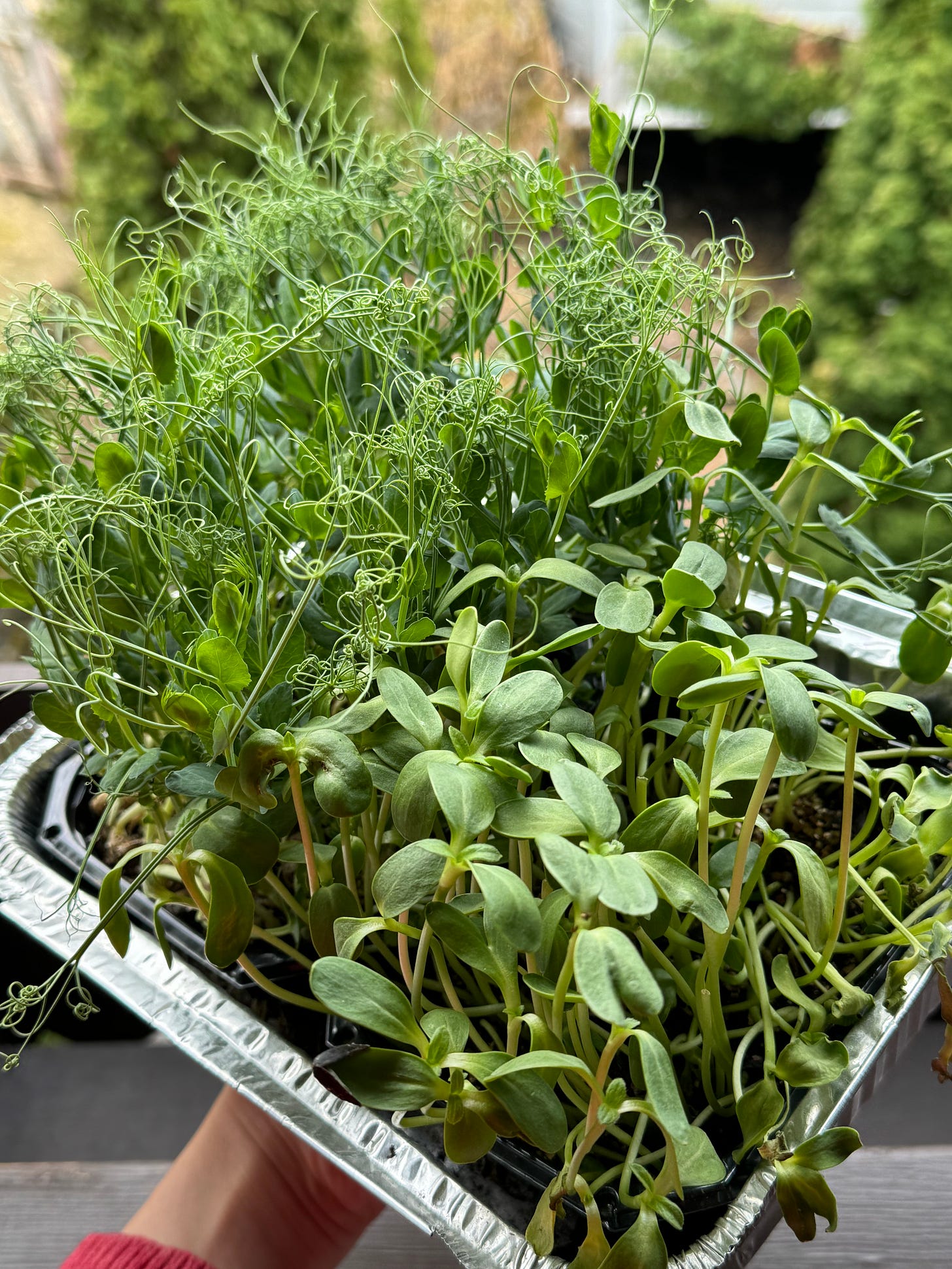Allô! 👋
Hello, and thank you for being here! Welcome (back) to the seasonal sundays section of the good food at home newsletter, where every week we take a closer peek at produce at its peak — with a short introduction, a recipe, and a (sometimes related) cooking Q&A. If you’re a new subscriber and would like to read the previous issues, you can click here to find them!
Happy Sunday! I hope you’re all doing well. This week, we’re putting the spotlight on sprouts, shoots, seedlings — microgreens! — and how to use them in speedy dishes like soups, salads, and sandwiches. (All the Ss!)
You probably don’t need me to tell you that we’re currently in peak microgreen season (if you’ve got a green thumb and access to a greenhouse, a cold frame, a community garden, or even just a balcony, stoop or windowsill, then you really don’t need me to tell you that we are in peak microgreen season). Most food growers in this hemisphere started planting their year’s first seeds at least two months ago already, and will continue to sow and be swimming in seedlings for at least a few more months as we move into summer with heat-loving, slow-maturing, and late season crops.
For the longest time, my impression of young plants like sprouts was that they could only ever appeal to folks with a strong hippy-like proclivity and a marked aversion towards any food that doesn’t taste like it’s good for you (not that I don’t like food that’s good for me… I just don’t want it to taste like that’s the only thing it’s got going for it).
After all, sprouts and microgreens are often touted for their health benefits, not their potentially delicate flavours, crisp textures, or refreshing aromas. Worse even, you’re more likely to hear of people getting sick from ingesting sprouts than of people getting healthy from eating them. Not exactly the sort of thing that makes you want to run to the shops so you can throw some onto your next meal...

That being said, there is a difference between the teeny, tiny moist tangles of sprouts you can quickly grow at home or buy at the grocery store (or local organic food co-op — think of alfalfa, radish, mung bean, and broccoli sprouts) and the larger, sturdier, more vibrant microgreens you end up with at home when growing your own veg (often also found at farm shops and farmers’ markets at this time of year) — things like pea shoots, sunflower seedlings, and young aromatics like shiso, lemon balm or coriander.
While sprouts are grown in water in a matter of days and can be eaten whole, microgreens are sown in soil, take a few weeks to develop true leaves, and are only consumed from the stem up. Both are delicious in my opinion, but microgreens do remain a personal favourite: compared to sprouts, they don’t (yet) come with health warnings, require little attention to grow, and are more of a seasonal treat. A perfect springtime appetiser for the summer bounty to come!

If you’ve been lucky enough in the past to have had some space to grow food, you’ll know that harvesting a plant at different stages in its growth cycle (sooner or later than an industrial farm growing for supermarkets ever could) is one of the great perks and thrills of doing things yourself. Young beet greens, apple blossoms, fresh garlic scapes, tender broccoli leaves, juicy green coriander seeds, chive flowers (before and after they bloom!), zingy green strawberries, fragrant oregano blossoms — the list goes on and on in terms of what you can pick and eat outside of a plant’s conventional harvesting period.
The wonderful thing about sprouts, however, is that you don’t even need space to grow food: very young seedlings don’t really require light, let alone soil. At the very start of their lives, they mostly require moisture and warmth, so starting seeds and sprouting shoots needn’t be dependent on having access to a garden. You don’t even need to start the seeds during any particular season! I’ve yet to grow my own sprouts at home so don’t feel all that confident recommending any resources for how to do it yourself, but if you’re interested, this article and this video should be all you need for getting started with microgreens. I’ve always found the process to be a real joy.
•••
As microgreens are so tender and young, I prefer not to cook them or even prepare them in any particular way (say, chopping or pickling them). They really do tend to be great on their own, simply washed, crisped up in cold water if desired, and dried well*. Because of this, instead of one recipe, you’ll be getting three ideas this week to hopeful inspire you to pop a handful or two of seedlings onto, into, or next to your next meal.
*for sprouts, on the other hand, I tend to be more cautious and do often like to at least blanch them
simple + speedy soups, salads & sandwiches 🌱
I used to work in a dreamy restaurant whose brunches would systematically have people lining up around the block for a taste of its renowned menu items, every single weekend. During the week, inventive hot meals would come off the pass for breakfast and lunch and inevitably tantalise guests, both old and new. Wedged into the famously small kitchen right by the front window, I worked the takeaway counter, where people would come to order pastries, coffees, or slow-cooked meals to heat up at home, and part of my job was also to plate and garnish soups, salads, and sandwiches, be they served on beautiful dishes and bowls for sit-in lunches, or in cool eco-friendly containers for meals to-go. I met some amazingly cool people while working there, and also learned an awful lot about restaurants and cooking, but one thing that especially stayed with me from my time in that establishment was just how satisfying something as simple as a soup, salad, or sandwich could be. Even better: one made with care, love, and the best ingredients. That’s what I had for lunch every day I worked there (either soup + salad, salad + sandwich, or sandwich + soup) and, for me, those classic staples remain a go-to lunch option to this day.
•••
In no particular order, here are three of my go-to no-recipe recipes for simple and speedy lunches:
Keep reading with a 7-day free trial
Subscribe to good food at home to keep reading this post and get 7 days of free access to the full post archives.







